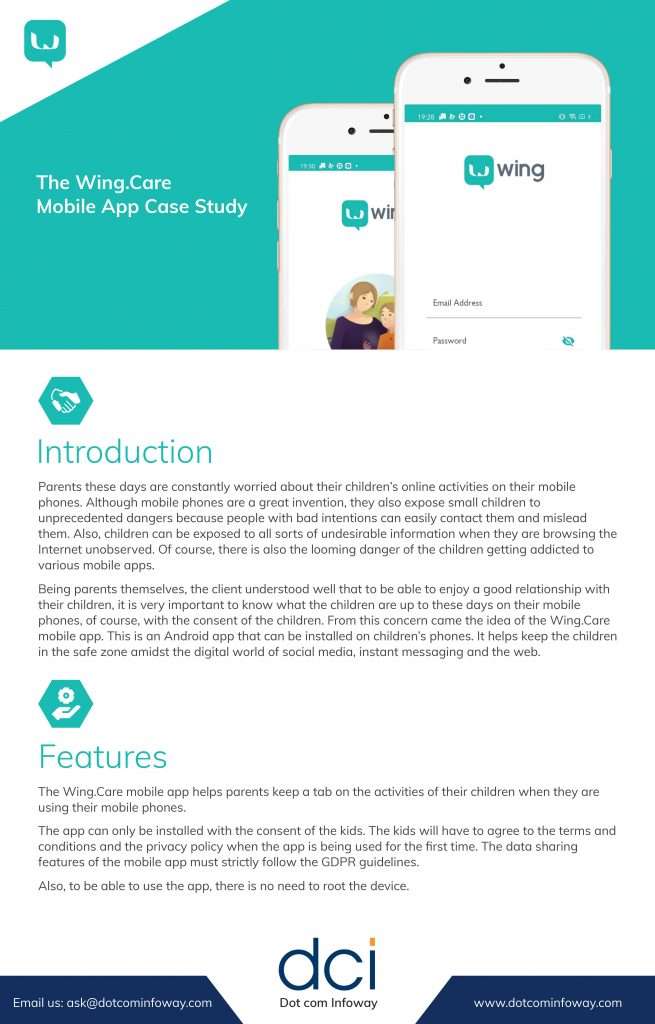The Wing.Care Mobile App Case Study
Introduction
Parents these days are constantly worried about their children’s online activities on their mobile phones. Although mobile phones are a great invention, they also expose small children to unprecedented dangers because people with bad intentions can easily contact them and mislead them. Also, children can be exposed to all sorts of undesirable information when they are browsing the Internet unobserved. Of course, there is also the looming danger of the children getting addicted to various mobile apps.
Being parents themselves, the client understood well that to be able to enjoy a good relationship with their children, it is very important to know what the children are up to these days on their mobile phones, of course, with the consent of the children. From this concern came the idea of the Wing.Care mobile app. This is an Android app that can be installed on children’s phones. It helps keep the children in the safe zone amidst the digital world of social media, instant messaging and the web.
Features
The Wing.Care mobile app helps parents keep a tab on the activities of their children when they are using their mobile phones.
The app can only be installed with the consent of the kids. The kids will have to agree to the terms and conditions and the privacy policy when the app is being used for the first time. The data sharing features of the mobile app must strictly follow the GDPR guidelines.
Also, to be able to use the app, there is no need to root the device.
The parents should be able to view the data on their own mobile phones. The data is extracted and preserved in such a format that later parents can perform analysis and determine the emotional and social impact the use of the mobile phone is having on their kids.
Challenges
As is apparent, the main strength of the app is the data that is extracted from multiple applications and then preserved in such a format that it can be used to generate reports and for analysis.
Data extraction from social media apps was a big challenge. As the successful extraction of data is the main strength of the application, we needed to find a workaround to get the data without violating the integrity of the operating system.
Proposed solution
Our development team explored various options and constantly kept in touch with the clients. The proposed solution worked to everybody’s satisfaction and we were able to extract enough data to give it a form.
As is the case with every project we undertake, we decided to approach in two phases, described below.
Phase 1
Phase 1 mostly involves both the parties coming on the same page and making sure that there is no communication gap. All the needed information is collected from the client. All the goals and expectations are taken note of. Aside from these the phase also involves
- Requirement gathering/elicitation: As explained above, to develop a mobile app, we need to thoroughly understand what is expected of the app and what should be the end result. Multiple communication sessions with the client help us glean all the needed information.
- Wireframing and prototyping: It is nearest to the actual app experience a client can get. Different wireframing and prototyping tools are used to create graphic flows and visual representations of the mobile app. The client can play around with different screens and experience first-hand how the data is going to be captured and ultimately, how it is going to be processed.
- Developing ER diagrams: This basically involves establishing relationships between the database and the mobile app back-end, in case a database is being used.
The client in this phase needs to feel confident and satisfied and only then the development team proceeds to the next phase.
Phase 2
This is the actual development. All the coding and design takes place in this phase based on the information gathered during Phase 1. Whether the phase 1 has been successful or not has a large impact on phase 2. Here are the steps involved
- Development/coding: The brick-by-brick construction of the program including programming and interface designing.
- Prototype integration: The features and the flowcharts we have mutually agreed with the client are implemented so that the app is finished as per the expectations of the client.
- Database: The information that is gathered is saved in the database so that it can be retrieved for reporting and analysis. The database design and the database connection happen according to the ER diagram.
- Deployment: The real testing of the mobile app happens when people can download it from respective app stores, install it and then run it on their devices. In this case, the Wing.Care mobile app was deployed on Google’s Android Play Store.
- Test running: Making sure everything works the way it should work and there are no bugs and errors. This is mostly done at our end.
- UAT: In case there are last minute changes to be made, we closely work with the client to incorporate the changes.
How we approached the challenge
The crux of the Wing.Care mobile app was the data that was to be extracted from multiple applications, and even while the children browsed the Internet.
It was a complicated process but ultimately, we were able to generate enough data for the clients to be able to draw conclusive intelligence.
Results
By the time we delivered the app, the clients were able to extract data from the following mobile apps and sources:
- SMS
- Call Logs
- YouTube History
- Snapchat
- Browser History
The client is quite happy with the result. The interface is smooth and easy, and all parents can use it. The mobile app adheres to the GDPR guidelines. Since it can be used only with the consent of the kids, even they feel empowered.







